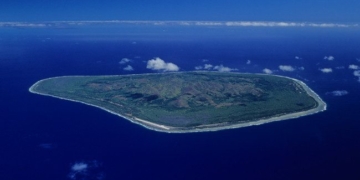In the future, a mountainside in Norway is set to collapse into the sea below, generating a powerful tsunami. Yet, despite the looming danger, residents near the fjord remain calm.
Mount Akerneset in western Norway, covered in green moss and shrubbery, has been gradually disintegrating for decades. The eastern slope of the mountain is eroding at a rate of 10 cm per year and is slowly sliding into the Sunnylvsfjorden fjord below, according to AFP. “The entire mountainside is very loose and shifting, which could lead to a significant collapse,” said geologist Lars Harald Blikra while standing next to a crack he has monitored for the past 20 years at the Norwegian Water Resources and Energy Directorate. “The falling rocks, breaking off from the large mountain mass, will plunge straight into the fjord, causing a strong tsunami. This event could happen within the next 2 to 3 years or within 50 years. We just don’t know for sure.”

Mount Akerneset is gradually breaking apart. (Photo: National Geographic).
According to a 2016 risk assessment by the Norwegian Directorate for Civil Protection, 54 million cubic meters of rock could break loose, generating tsunami waves up to several tens of meters high in just a few minutes, flooding 10 villages along the narrow fjord. In 1934, a landslide just a few kilometers away triggered a dangerous tsunami reaching heights of 64 meters, claiming the lives of 40 people.
Located at the innermost corner of the fjord, the villages of Hellesylt and Geiranger face the highest risk. In the worst-case scenario, these tourist hotspots could be submerged by waves reaching 70 to 80 meters high. Olav Arne Merok, a 70-year-old resident who has lived his entire life in Geiranger, would be among those affected. “Here, we live at an elevation of 30 to 40 meters. Clearly, if there were a wave 90 meters high, we would be underwater. But we can’t live in constant fear thinking about it,” Merok explained.
At the dock where many cruise ships anchor during the summer, 69-year-old boat agent Geir Gjorva also appeared unperturbed. “No one knows how big the wave will be. It could come slowly or quickly. It’s not a topic we discuss every day. People know that the warning systems and emergency measures are functioning well,” Gjorva shared.
Due to the lurking danger, Akerneset is one of the most closely monitored mountains in the world. A series of GPS devices and terrestrial surveying equipment, along with underground sensors, track every movement of the mountain to provide alerts if necessary. According to geologists, the mountainside will not fall directly into the sea without warning signs. Before the main fracturing event, there will be multiple indicators, allowing sufficient time for the evacuation of local residents.
“Evacuating thousands of people from a small area due to the risk of landslides is a nightmare for a mayor,” Einar Arve Nordang, the newly appointed mayor of Stranda, which includes the villages of Hellesylt and Geiranger, admitted. “But we are prepared.” All emergency plans are in place, and every agency knows what to do when disaster strikes.
At the summit of Akerneset, experts are exploring ways to delay the disaster. One possibility is to drain water from the mountain, which acts as both a lubricant and pressure stabilizer. However, this is complex and costly, as all equipment needs to be transported by helicopter. Sverre Magnus Havig, director at the Norwegian Water Resources and Energy Directorate, stated that such measures could significantly extend the timeline for the mountain’s collapse. “Instead of a landslide occurring within a hundred or two hundred years, it could happen in another thousand years,” Havig said.


















































